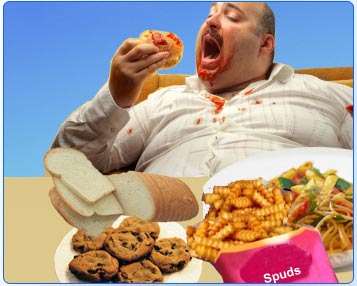Today everyone is aware of the fact that to stay healthy and fit, one must maintain a healthy diet routine. A balanced diet consists of all the essential nutrients required in the appropriate quantities to allow the body to function properly and fight against diseases. Among the various nutrients that the body requires, carbohydrates are the must-haves as they are responsible for supplying energy to the body to function well.
But all carbohydrates are not good for all individuals. Some are good carbs while others are known as the bad carbs. This is especially true when you are overweight or a diabetic. Hence it is important to know the different types of carbohydrates present in the different foods and their effects on the health.
What are carbohydrates?
Carbohydrates are biological molecules that consist of carbon, hydrogen and oxygen atoms. A combination of all these atoms is termed as carbohydrates and these micro-nutrients are available in many foods and beverages. Some are better than the others and it is your healthy choice that helps to keep you fit and strong.
Types of Carbohydrates
There are 3 main types of Carbohydrates namely Sugar, Starch and Fiber. Now let us consider each type separately and find out their uses and in which foods they are available.
- Sugar: – Sugar is the simple type of carbohydrate and is naturally present in various foods and drinks. It contains only one or two molecules of sugar. Some of the common sugars are glucose, sucrose, fructose and lactose. Glucose is referred to as blood sugar. Sugar easily mixes with the blood stream as it has very few molecules and is digested quickly. However, sugar from natural whole foods boosts the energy level as it contains other important nutrients. But added sugar is not good for health.
- Starch: – Starch is a complex carbohydrate and consists of a number of sugar molecules. It usually has thousands of sugar molecules that are connected together like branches and spiral shapes. When it is digested the enzymes in the stomach break the molecules till a single sugar molecule or monosaccharide remains which can enter the cells through the bloodstream and convert it into energy. Starches are digested at varying rates and when they are digested slowly, they help to feel full and supplies long-term energy. Starches that are digested quickly are not good for health as they increase blood sugar levels causing diabetes. There are some foods that contain all the 3 types of carbohydrates and cannot be easily separated from each other or labeled out.
- Fiber: – Carbohydrates present in fiber are not digested but travel down the digestive tract and ferment in the large intestine. There are two types of fibers namely soluble and insoluble. Soluble fiber keeps the blood sugar steady by absorbing carbs at a slower rate and also helps to control cholesterol levels and absorption of dietary fat. Insoluble fiber is important for taking care of digestion and the digestive tract and preventing constipation.
- There are other terms also used frequently regarding carbohydrates. They are the low-carbs and net-carbs. They are visible mostly on the labels of products. Net carbs is generally used to denote the total amount of carbohydrates present in a product excluding fiber or both sugar alcohol and fiber. Low-carbs are those foods that have the good carbs and do not increase the blood sugar levels.
- Glycemic index is a term that is also used with reference to carbohydrates. It classifies the foods that contain carbohydrates according to their ability to increase the sugar level of blood.
Foods that contain the different types of Carbohydrates
Carbohydrates are present in almost all the foods that we consume regularly like the vegetables and fruits as well as beverages. But the types and amount s of carbs vary from one item to another. Some contain more of sugar, while others are rich in fibers and others have more of starch. So selecting the right carbs according to your requirements is very important to maintain good health. Those have diabetic problems or obesity issues need to be more careful about the choice of carbohydrates in their diet.
Sugar
Foods that contain more of sugar are fruits and vegetables which contain fructose and sucrose. Lactose is present in milk and it is natural sugar. There are certain foods that we love to eat that are rich in sugar contents like cookies, cakes, pies, brownies, muffins, doughnuts, jams, spreads, preserves, sweetened fruits and cherries, apricots, raisins, bananas, prunes, peaches etc.
Starch
Starch is a complex carbohydrate and is a friend of your health. But it is important to get this starch from the proper sources that include fresh produce, legumes and whole grains. Corn, parsnips, potatoes, green peas, yams, winter squash and pumpkins are good sources of starch. Among the fruits you can rely on avocadoes, mangoes, peaches, apples, grapefruit, melons, grapes, berries, peaches, nectarines for your regular starch requirements. You can get starch from white beans, black kidney, pinto, baked and canned beans, yellow, brown or green lentils as additional supply of good quality starch.
Fibers
Insoluble fibers are found in whole grains, vegetables like carrots, tomatoes, celery and wheat cereals. Cooked dry beans and peas also have fibers that help in proper bowel movements. Good sources of soluble fibers are barley, beans, oatmeal beans, nuts and fruits like berries, apples, pears and citrus fruits.
How to choose the right types of carbohydrates according to your body types
Carbohydrates are considered to increase weight and sugar levels in persons who have a tendency of gaining weight easily and those who have stress and tension related problems. Such persons need to very careful when selecting their carbohydrates. For others carbohydrates are vital for the following reasons:
Ø Carbohydrates provide energy and are the main sources of fuel. Sugars and starches are changed into simple sugars during the process of digestion that are absorbed into the bloodstream which then enters the cells of the body with the insulin produced by the pancreas. This glucose is used by the body for fueling all our activities from morn till night.
Ø Carbohydrates available in the form of dietary fiber in whole grains and wheat cereals and others help to fight against diseases like type 2 diabetes, obesity issues and cardiovascular problems. Fibers are extremely important for proper digestion.
Ø Eating the right carbs like whole grains, fruits and vegetables that are rich in fibers helps in controlling weight. They give you a feeling of fullness and restrict your food cravings thereby reducing weight as well.
Since you cannot stay without carbohydrates it is wise to choose the appropriate ones that will do well for your overall health. You can even consult a doctor and ascertain the perfect amount of carbohydrates that you need daily as requirements vary according to weight and activities of an individual. Those who do a lot of outdoor activities and are into sports, need more energy and so more carbohydrates. They do not have to worry whether the extra carbs are being stored as fats or not as all the carbs are burned out. But in case who work indoors behind cubicles for most of the day, then emphasizing on fiber-rich fruits and vegetables, whole grains, beans and legumes will be the best for you.
I want to thank everyone for all of your support. Please keep the suggestions coming..
by Kevin Angileri



